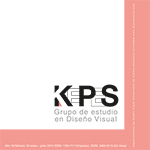Autores
Resumo
La generación de estrategias de comunicación que permitan acercar al público con discapacidad visual a los museos se ha convertido en un desafío importante para la museología. Como respuesta a esta necesidad se diseñó, prototipó y evaluó un sistema de navegación para ambientes internos que permite a las personas con discapacidad visual acceder a exposiciones en el Museo de Ciencias Naturales de La Salle del Instituto Tecnológico Metropolitano (Medellín, Colombia). El procedimiento utilizado se presenta como una metodología con dos etapas. La primera consistió en el diseño y desarrollo del prototipo del sistema de navegación y la segunda consistió en la evaluación del sistema. El diseño del sistema fue el resultado de la adaptación de metodologías contemporáneas de innovación tales como el Design Thinking y el Creative Problem Solving (CPS), aplicadas al diseño de productos tecnológicos. Se desarrolló un prototipo funcional que incluía una aplicación iOS para teléfonos inteligentes, guías podotáctiles, auriculares de conducción ósea, detectores de obstáculos e identificadores de códigos QR. Durante la etapa de evaluación se llevaron a cabo experimentos en una de las salas del museo con 27 personas, quienes presentaban discapacidad visual. Los resultados indicaron que el sistema desarrollado es eficaz como herramienta de navegación y que proporciona información acerca de los especímenes en una exposición, lo que permite concluir que esta experiencia es replicable en otros entornos museográficos y en otros museos.
Referências
Ahmetovic, D. et al. (2017). Achieving practical and accurate indoor navigation for people with visual impairments. En 14th Web for All Conference on The Future of Accessible Work, ACM, Western Australia, Australia.
Basso, S. et al. (2015). A smartphone-based indoor localization system for visually impaired people. En International Symposium on Medical Measurements and Applications (MeMeA) Proceedings, Turin, Italy.
Bellotti, F. et al. (2006). Guiding visually impaired people in the exhibition. Mobile Guide, 6, 1-6.
Bhowmick, A. and Hazarika, S.M. (2017). An insight into assistive technology for the visually impaired and blind people: State-of-the-art and future trends. Journal on Multimodal User Interfaces, 11 (2), 149-172.
Buyurgan, S. (2009). The Expectations of the Visually Impaired University Students from Museums. Educational Sciences: Theory and Practice, 9 (3), 1191-1204.
Brown, T. (2009). Change by Design: How Design Thinking Transforms Organizations and Inspires Innovation. New York, USA: Harper Collins.
Campbell, M. et al. (2014). Where’s my bus stop?: Supporting independence of blind transit riders with StopInfo. En 16th International ACM SIGACCESS Conference on Computers & Accessibility, ACM, New York, USA.
Chumkamon, S., Tuvaphanthaphiphat, P. and Keeratiwintakorn, P. (2008). A blind navigation system using RFID for indoor environments. En 5th International Conference on Electrical Engineering/Electronics, Computer, Telecommunications and Information Technology, Krabi, Thailand.
Csapo, A. et al. (2015). A survey of assistive technologies and applications for blind users on mobile platforms: A review and foundation for research. Journal Multimodal User Interfaces, 9, 275-286.
Fallah, N. et al. (2012). The user as a sensor: Navigating users with visual impairments in indoor spaces using tactile landmarks. En CHI Conference on Human Factors in Computing Systems, ACM, Texas, USA.
Filipe, V. et al. (2012). Blind navigation support system based on Microsoft Kinect. Procedia Computer Science, 14, 94-101.
Flores, G. et al. (2015). Vibrotactile guidance for wayfinding of blind walkers. IEEE Transactions on Haptics, 8 (3), 306-317.
Ganz, A. et al. (2014). PERCEPT-II: Smartphone based Indoor Navigation System for the Blind. En 36th Annual International Conference of the IEEE Engineering in Medicine and Biology Society, Chicago, USA.
Handa, K., Dairoku, H. and Toriyama, Y. (2010). Investigation of priority needs in terms of museum service accessibility for visually impaired visitors. British Journal of Visual Impairment, 28 (3), 221-234.
Hurtado, M.D. y Soto, F.J. (2008). La igualdad de oportunidades en el mundo digital. Murcia, España: Consejería de Educación, Ciencia e Investigación.
Jain, D. (2014). Path-guided indoor navigation for the visually impaired using minimal building retrofitting. En SIGACCESS conference on Computers & Accessibility, ACM, New York, USA.
Jiménez, C., Seibel, C. y Soler, S. (2012). Museos para todos. La traducción e interpretación para entornos multimodales como herramienta de accesibilidad universal. MonTI. Monografías de Traducción e Interpretación, 4, 349-383.
Kleeman, L. (1992). Optimal estimation of position and heading for mobile robots using ultrasonic beacons and dead-reckoning. En Proceedings 1992 IEEE International Conference on Robotics and Automation, Nice, France.
Leavy, B. (2010). Design thinking–a new mental model of value innovation. Strategy & Leadership, 38 (3), 5-14.
Panëels, S.A. et al. (2013). The walking straight mobile application: Helping the visually impaired avoid veering. Recuperado de https:// smartech.gatech.edu/bitstream/handle/1853/51516/03_S1-2_Paneels.pdf?sequence=1&isAllowed=y.
Parnes, S.J. (1992). Sourcebook for creative problem solving. Buffalo, USA: Creative Education Foundation.
Perdomo, J. (2009). Una mirada a las prácticas de inclusión y de exclusión en los museos. Códice, 20, 16-21
Nakajima, M. and Haruyama, S. (2013). New indoor navigation system for visually impaired people using visible light communication. EURASIP Journal on Wireless Communications and Networking, 37. Recuperado de https://jwcneurasipjournals.springeropen.com/articles/10.1186/1687-1499-2013-37.
Nakamura, K., Aono, Y. and Tadokoro, Y. (1997). A walking navigation system for the blind. Systems and Computers in Japan, 28 (13), 36-45.
Soler, S. y Chica, A. (2014). Museos para todos, evaluación de una guía audiodescriptiva para personas con discapacidad visual en el museo de ciencias. Revista Española de Discapacidad, 2 (2), 145-167.
Shoval, S., Borenstein, J. and Koren, Y. (1998). Auditory guidance with the navbelt-a computerized travel aid for the blind. IEEE Transactions on Systems, Man, and Cybernetics, Part C (Applications and Reviews), 28 (3),459-467.
Ulrich, K. and Eppinger, S. (2015). Product design and development. New York, USA: McGraw-Hill Higher Education.
Xie, B. et al. (2016). LIPS: A light intensity based positioning system for indoor environments. ACM. Transactions on Sensor Networks, 12 (4), 28-42.
Wylant, B. (2008). Design thinking and the experience of innovation. Design Issues, 24 (2), 3-14.

 pdf (Español (España))
pdf (Español (España))
 FLIP
FLIP





















